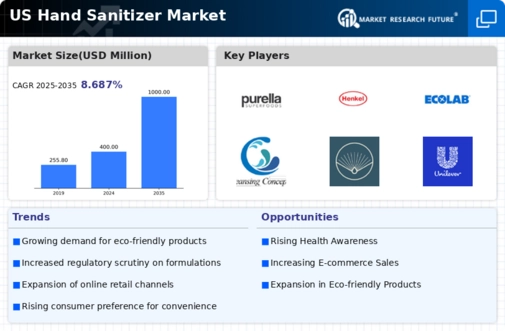Expansion of Retail Channels
The expansion of retail channels significantly impacts the hand sanitizer market, as consumers gain easier access to a variety of products. Retailers, including pharmacies, supermarkets, and online platforms, are increasingly stocking hand sanitizers, catering to the growing demand. This trend is reflected in the market data, which indicates that online sales of hand sanitizers have surged by 15% in the past year alone. The hand sanitizer market is thus poised for further growth as more retail outlets recognize the profitability of offering diverse hand sanitizer options to consumers.
Regulatory Support and Standards
The hand sanitizer market benefits from robust regulatory support and established standards that ensure product safety and efficacy. Regulatory bodies, such as the FDA, have implemented guidelines that govern the formulation and labeling of hand sanitizers. This regulatory framework not only enhances consumer trust but also encourages manufacturers to innovate and improve their products. The hand sanitizer market is likely to see an increase in compliance-driven innovations, which could lead to a 10% rise in market value over the next few years as companies strive to meet these standards.
Rising Consumer Awareness of Hygiene
The hand sanitizer market is experiencing a notable surge due to increasing consumer awareness regarding hygiene practices. This heightened consciousness is largely driven by educational campaigns and public health initiatives that emphasize the importance of hand hygiene in preventing illness. As a result, consumers are more inclined to purchase hand sanitizers, leading to a projected growth rate of approximately 8% annually in the market. The hand sanitizer market is thus witnessing a shift in consumer behavior, with individuals prioritizing products that promote cleanliness and safety in their daily lives.
Innovations in Formulation and Packaging
Innovations in formulation and packaging are driving the hand sanitizer market forward, as manufacturers seek to differentiate their products in a competitive landscape. New formulations that include moisturizing agents or natural ingredients are becoming popular, appealing to health-conscious consumers. Additionally, eco-friendly packaging solutions are gaining traction, aligning with consumer preferences for sustainable products. The hand sanitizer market is likely to see a 12% increase in sales attributed to these innovations, as they not only enhance user experience but also address environmental concerns.
Increased Usage in Institutional Settings
The hand sanitizer market is witnessing increased usage in institutional settings such as schools, hospitals, and workplaces. These environments are prioritizing hygiene protocols, leading to a higher demand for hand sanitizers as a preventive measure against infections. Market analysis suggests that institutional sales could account for up to 30% of total hand sanitizer sales in the coming years. The hand sanitizer market is thus adapting to this trend by offering bulk purchasing options and specialized products tailored for institutional use, further driving market growth.






















Leave a Comment